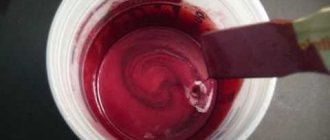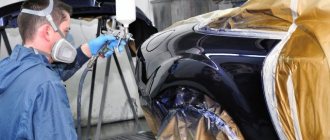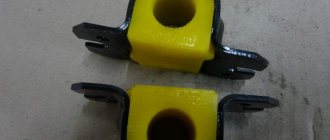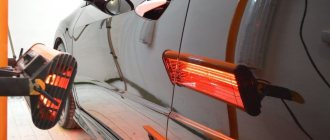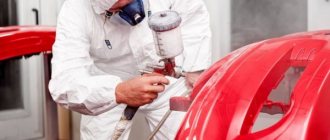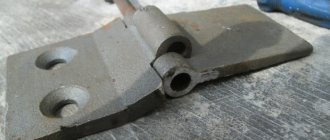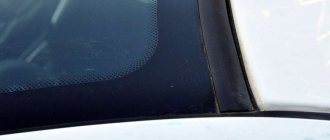It is impossible to say exactly how much paint will be spent on painting a car, but there are basic principles that will help you understand the paint consumption when painting a car body.
The amount of paint is affected by:
- Machine size
- Paint color and original body color
- Paint quality
- Spray gun type
- Painter experience
Let's take a closer look at each point.
Paint color and original body color
The amount of paint required to paint a car depends on what color the car will be painted and what the original color of the surface to be painted is. If the body panel has a color contrasting to the one being sprayed, then more paint will be needed. Colors such as yellow, red, and blue are low opaque, so more paint may be needed to cover the original color. If the paint has low coverage, then it is necessary to apply more layers to paint the substrate. For example, when painting with red and yellow paint, up to 10 or more layers may be required.
Colors such as black, white, and bright green have good hiding power.
If a car is repainted due to numerous minor defects and scratches that are sanded off during preparation of the body for painting, then less paint will be used than when changing the color of the car.
The color of the substrate will affect the final shade of the paint.
Note: Hiding power is the ability of paint, when sprayed, to completely cover the color of the surface, that is, to cover the color of the substrate with the sprayed color. Thus, the more opaque the paint, the less it will be needed to paint the part.
Door painting
When starting painting, you need to remember the following. The plane to be painted must be installed vertically, and the spray gun must be held strictly perpendicular to the surface at a distance of at least 20 cm. The first layer of paint is applied in horizontal stripes from top to bottom with a thin translucent layer. The thinner the layer, the lower the risk of drips, since car paint is very fluid. Each subsequent layer is applied perpendicular to the previous one. The stripes of paint should overlap each other by half. How many layers are required will be seen by the evenness of the shade. After applying several layers, you can again check for defects and rub them with fine sandpaper. After painting the car door is completed, the part is dried in accordance with the paint instructions, and then the surface is varnished in the same way as painting.
It should be remembered that a fresh coat of paint is quite delicate at first, so it is better not to rush to install all the elements on the door.
Spray gun type
Paint consumption is significantly affected by the design of the spray gun. HVLP spray guns have a high percentage of paint and varnish material transfer to the surface being painted. For high-quality HVLP spray guns, this percentage is at least 75%. When painting with such spray guns, the paint gets onto the part as much as possible, and does not fly to the sides.
From personal experience I can say that when I take high-quality paint in the quantity recommended for painting the parts I need, the paint often remains (sometimes more than half). I paint with an Iwata W‑101 spray gun, purchased from an official representative in Russia. From my own experience I am convinced that a high-quality, economical spray gun significantly reduces paint consumption.
Car body painting
You can achieve high savings by choosing colors that are similar to the color of the car before it was repainted. A full car repaint will require more coats of paint than a simple tint change. If you want to restore the color of only the damaged part, it will be much cheaper than completely repainting the car.
It is also worth remembering: how much paint is needed to paint a car depends on the method of work and the brand of spray gun used. It is worth noting that some of the paint remains on the walls of the spray gun tank. Alkyd enamel typically costs 35-55% more than acrylic car paint to cover the same surface. The amount of paint consumed depends on the size of the car. It takes from 2.5 to 3 liters of liquid to completely paint the body.
The main parameter of car paint consumption is viscosity. An incorrectly diluted composition will not only increase paint consumption, but may even ruin it. Paint that is too thin will not set well and will spread in drops over the body, while paint that is thick will cause an orange peel effect on metal parts. In both cases, you will have to sand and repaint. There is a tool specifically to avoid such mistakes - a viscometer. If this device is not available, you can use a marked container and a ruler.
The viscometer's operating methods are based on determining the required viscosity by the time during which the liquid is poured into the tub through a special hole (it is convenient to count the time with a stopwatch). Another option is to pour paint into the container and measure the exact amount of liquid poured with a ruler, so we can find out the required amount of solvent. To find out the exact proportion, you need to look at the can of paint; the method of application indicates the ratio of paint and solvent.
Painter experience
The amount of paint required to paint a car body also depends on the professionalism of the car painter. An experienced painter will set up the paint gun correctly and distribute the paint correctly. The paint should not be applied in the form of dust, but should spread well when it hits the surface. It is wiser to first paint over repair areas and replacement body panels that are a different color than the rest of the body. Then you can proceed to the step-by-step painting of all body parts.
Car paint – which one to choose?
Paint consumption on a car will also depend on the type of paint coating chosen. Any paint contains several essential components:
- Pigment (the color of the chosen paint depends on it).
- Binder (thanks to it, the pigment is firmly attached to the surface of the body).
- Solvent (gives the paint the necessary fluidity).
Acrylic enamels are considered the most popular car paints. Their main advantages are the price-quality ratio; they allow you to obtain a uniformly colored surface that has a good shine.
dye
Such paints dry quickly and are resistant to various mechanical influences. How many liters of paint do you need to paint a car? If acrylic enamel is used, the consumption will be about 2 liters, but you need to remember that if you plan to paint the inside of the body as well, the consumption will increase by 1-1.5 liters.
Acrylic paint for car painting has many advantages, but it is difficult to polish. Therefore, if the car needs to be repainted, it is better to use soft paints that are easier to polish.
Base paint + varnish
If the car will be painted with paint that requires further varnish, then more varnish may be required than base paint. It is necessary to create a certain thickness with varnish, since it is a protective coating. For example, if it takes about 2 liters of base paint to paint the body, then 3 – 3.5 liters of varnish may be required. Even if a smaller amount of varnish is used, it is better to take it in reserve and dilute it not all at once, but as it is used. The remaining, undiluted varnish will be useful in the future when painting any car.
In general, the amount of varnish depends on the area to be varnished, and not on the amount of base paint. The amount of paint and varnish may be the same.
Average consumption rates
On average, 1 m² requires 200-250 ml of undiluted paint, and to treat various body elements, if up to 50% of the surface is damaged, the following amount will be required:
- on the door or rear fender - 150 ml;
- on the hood – 200 ml;
- on the threshold or radiator grill - 50 ml;
- on the front or rear bumper - 100 ml;
- on the trunk lid - 300-400 ml;
- for the inside of the car - up to 1.5 liters.
If the surface of a part is damaged by more than 50%, paint consumption increases by 1.5-2 times.
Please note: Painting the steering wheel
Alkyd enamel requires 40-50% more than acrylic enamel. So, for a medium-sized car you will need 3-3.5 liters of the first or 2-2.5 liters of the second paint.
Brands of paints and varnishes of different brands differ in composition and, despite the same color, have different covering abilities. Calculation of the consumption of paints and varnishes is made after determining the scope of work.
The amount of paint required to paint the entire car
If you use paint economically, you may need 2 kg of paint for the entire car. You need about the same amount of varnish.
Basically, 2–2.5 kg of undiluted paint is enough to paint a four-door sedan. Since the base paint is diluted 1 to 1 (1 liter of paint is mixed with 1 liter of thinner), you will get twice as much diluted paint.
If the car needs to be painted along with all the openings, then you will need 0.5 - 1 kg more paint. Since the base paint is usually diluted 1 to 1, the amount of paint diluted for spraying will be 2 times greater.
We determine the paint consumption for painting a car. Table for calculating the required volume of material.
When you paint a car yourself, you save a lot of money, which is why many people are interested in the question of the technology for carrying out all the work. But one of the main questions that worries novice car painters is: “What is the paint consumption for a car?” Paint is not a cheap material at all, and you don’t really want to buy too much; you’ll end up throwing money away. You will not be able to get an exact answer to this question, since many factors influence the volume of material.
What affects consumption?
At first glance, the main parameters include the surface area that needs to be processed and the number of layers of material that are planned to be applied.
But in fact there are other factors.
- technology of applying the material by a master. This includes the ability to spray an even layer of material without overspray.
- thickness and number of paint layers.
- type of paint and its parameter such as surface coverage.
- paint viscosity. If the paint is diluted too little with solvent, it will be viscous, and the dried surface will have a shagreen effect. If the material is heavily diluted, there is a high probability of smudges. The best solution, if possible, would be to use a viscometer and strictly follow the instructions provided by the manufacturer.
- color and quality of the prepared surface. This step can also significantly reduce your car's paint costs. A well-sanded P800 - P1000 primer surface and a good primer that matches the basecoat tone can reduce the number of coats of paint applied and save you money.
- spray gun settings. Here, first of all, there is a question of choosing the diameter of the nozzle and the uniformity of air supply from the compressor. It is advisable to first try to apply a layer of material on a test surface, and then begin finishing the car.
- temperature of the working environment in the room.
Related article: Tips for priming a car before painting. Technology, materials and advice on the implementation of work.
In particular, many craftsmen recommend the use of primers, paints and varnishes from the same manufacturer. This way, you can avoid defects and save on car paint consumption for all sorts of alterations.
Which paint should you choose for your car?
In fact, there are several different types of auto enamels that are used to apply to the car body at home.
- Nitro enamels. They are characterized by a number of disadvantages. Firstly, they are flammable. Secondly, they quickly fade and collapse. Thirdly, they are usually applied in a thin layer and you will need several coats. They are being replaced on the market by more modern solutions.
- Glypthal. These materials take a very long time to dry, taking 2 to 4 weeks, and for drying itself it is necessary to maintain fairly high temperatures.
- Acrylic enamels. These are the most popular types of material on the market. They dry quickly and the end result is a high quality surface. They are usually two-component and during operation are diluted with a hardener, which speeds up the polymerization process. You can use varnish in combination to add shine. In most cases they are applied either with a spray gun or a spray can.
- Alkyd paints. Compared to acrylic materials, they take longer to dry and are difficult to polish.
Car paint consumption rates
On average, to paint, for example, a door or fender, you will need about 150 ml of paint, about 250 - 300 ml of material for a bumper, and about 600 ml for a hood.
On average, the consumption rate is 200-250 ml per 1 sq.m. treated surface. The varnish consumption is approximately the same, this does not take into account the solvent and hardener.
An average sedan, if the technology is followed, requires about 2 - 2.5 liters of acrylic paint, excluding solvent and hardener. If you use alkyd paint, its consumption will be slightly higher than 3 - 3.5 liters. If your task is to paint all surfaces inside the body, then the material consumption will increase by 1.5 - 2 times.
Related article: How to dilute varnish for car painting? Basic recommendations.
If, when repainting a part, the old paint was, for example, black, and you decided to apply a white layer, then the consumption will increase by 50%. This occurs due to the application of additional overlapping layers.
We will provide a table that will help you roughly navigate the paint consumption for individual parts of the car body.
Here is a useful video on the topic of calculating material consumption when painting a car.
What if you use aerosol cans?
They are mainly used for local repairs, and one can has a volume of 150 grams of paint. The average paint consumption for painting a car using an aerosol can will be from 0.25 sq.m. up to 0.5 sq.m.
For 1 sq.m. For the surface to be treated, we will need about 2 - 4 cans of paint and the same amount of varnish.

